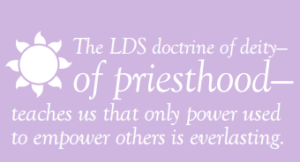We often treat power as if it were in short supply–as something to be hoarded rather than shared. We see the result heartbreakingly played out over and over in the form of political, judicial, economic, racial and gender inequality.
Christ was crucified for suggesting it could be otherwise.
Central to the LDS doctrine of deity and priesthood is a simple truth I learned from a Christian scholar: Power used to control or dominate others will always burn itself out. Only power used to empower others is everlasting.
This is consonant with one of Mormonism’s most transformative teachings, namely, that God doesn’t hoard power or reserve it for an elite few but shares it liberally with us. Our lay priesthood exemplifies this compelling democratization of God’s power. Unfortunately, our present exclusive, male priesthood policy only extends its institutional function to half of us and obscures whatever power is given to women through temple ordinances.

I wrote in OW’s Conversations that the events in the Bible and early Mormonism took place in societies hostile to women’s equality. Yet, there are many examples of women’s empowerment, including their apparent ability to exercise what we recognize now as priestly authority. In the Bible, there are examples of women prophetesses—Miriam (Exodus 15:19- 22), Deborah (Judges 4:4-5), Huldah (2 Kings 22:14-17), Anna (Luke 2:27, 36-38)—and women, during the first century after Christ’s ministry, who were referred to as deaconesses—Priscilla and Phoebe—and apostles—Junia (See Romans 16 NRSV).
According to the Nauvoo Relief Society Minute Book, Joseph Smith gave keys of administration and the promise of priestly authority to members of the Nauvoo Female Relief Society and endowed women with priestly power through temple rituals, which they used to bless each other and administer their organization. After Joseph’s death, Mormon women gradually lost institutional authority, the ability to perform blessings and the vision of themselves as endowed with priestly power, particularly after the priesthood correlation program was implemented in the 20th century.
If Joseph believed God intended full priesthood power, authority, and offices for the women of the Church, his vision was never fully realized. But can it be? Indeed, must it be?





